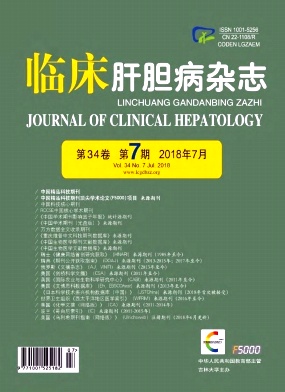|
[1]TORRE LA, BRAY F, SIEGEL RL, et al.Global cancer statistics, 2012[J].CA Cancer J Clin, 2015, 65 (2) :87-108.
|
|
[2]Ministry of Health of the People's Republic of China.Diagnosis, management, and treatment of hepatocellular carcinoma (V2011) [J].J Clin Hepatol, 2011, 27 (11) :1141-1159. (in Chinese) 中华人民共和国卫生部.原发性肝癌诊疗规范 (2011年版) [J].临床肝胆病杂志, 2011, 27 (11) :1141-1159.
|
|
[3]LENCIONI R, LLOVET JM.Modified RECIST (mRECIST) assessment for hepatocellular carcinoma[J].Semin Liver Dis, 2010, 30 (1) :52-60.
|
|
[4]HSU C, SHEN YC, CHENG CC, et al.Geographic difference in survival outcome for advanced hepatocellular carcinoma:Implications on future clinical trial design[J].Contemp Clin Trials, 2010, 31 (1) :55-61.
|
|
[5]TINKLE CL, HAAS-KOGAN D.Hepatocellular carcinoma:Natural history, current management, and emerging tools[J].Biologics, 2012, 6:207-219.
|
|
[6]ZHAO RR, DENG YD, YUAN H.Epidemiological and clinical features of primary liver cancer:An analysis of 236 patients[J].J Clin Hepatol, 2016, 32 (8) :1538-1542. (in Chinese) 赵荣荣, 邓永东, 袁宏.236例原发性肝癌患者流行病学及临床特点分析[J].临床肝胆病杂志, 2016, 32 (8) :1538-1542.
|
|
[7]LU LG.Advances in early screening and diagnosis of hepatocellular carcinoma[J].J Clin Hepatol, 2017, 33 (7) :1257-1261. (in Chinese) 陆伦根.原发性肝癌的早期筛查及诊断[J].临床肝胆病杂志, 2017, 33 (7) :1257-1261.
|
|
[8] CENTER MM, JEMAL A.International trends in liver cancer incidence rates[J].Cancer Epidemiol Biomarkers Prev, 2011, 20 (11) :2362-2368.
|
|
[9]de MARIA N, MANNO M, VILLA E.Sex hormones and liver cancer[J].Mol Cell Endocrinol, 2002, 193 (1-2) :59-63.
|
|
[10] MARRERO JA, KUDO M, BRONOWICKI JP.The challenge of prognosis and staging for hepatocellular carcinoma[J].Oncologist, 2010, 15 Suppl 4:23-33.
|
|
[11]LIU JY, JIN J, GUAN S, et al.The effect of hepatic function status on the survival time in patients with advanced hepatocellular carcinoma after transcatheter arterial chemoembolization[J].J Intervent Radiol, 2013, 22 (3) :247-250. (in Chinese) 刘纪营, 金洁, 管生, 等.肝功能状态对晚期肝癌介入治疗生存期的影响[J].介入放射学杂志, 2013, 22 (3) :247-250.
|
|
[12] XUE TC, XIE XY, ZHANG L, et al.Transarterial chemoembolization for hepatocellular carcinoma with portal vein tumor thrombus:A meta-analysis[J].BMC Gastroenterol, 2013, 13:60.
|
|
[13]RAOUL JL, BRUIX J, GRETEN TF, et al.Relationship between baseline hepatic status and outcome, and effect of sorafenib on liver function:SHARP trial subanalyses[J].J Hepatol, 2012, 56 (5) :1080-1088.
|
|
[14]CHENG AL, GUAN Z, CHEN Z, et al.Efficacy and safety of sorafenib in patients with advanced hepatocellular carcinoma according to baseline status:Subset analyses of the phase III Sorafenib AsiaPacific trial[J].Eur J Cancer, 2012, 48 (10) :1452-1465.
|
|
[15]WU ZY.Risk factors of prognosis in patients with advanced liver cancer after transcather arterial chemoembolization[J].J Pract Hepatol, 2015, 18 (4) :427-429. (in Chinese) 吴照宇.中、晚期肝癌介入治疗预后的影响因素分析[J].实用肝脏病杂志, 2015, 18 (4) :427-429.
|
|
[16]NIU ZJ, MA YL, KANG P, et al.Transarterial chemoembolization compared with conservative treatment for advanced hepatocellular carcinoma with portal vein tumor thrombus:Using a new classification[J].Med Oncol, 2012, 29 (4) :2992-2997.
|
|
[17]NISHIKAWA H, OSAKI Y, KITA R, et al.Comparison of transcatheter arterial chemoembolization and transcatheter arterial chemotherapy infusion for patients with intermediate-stage hepatocellular carcinoma[J].Oncol Rep, 2014, 31 (1) :65-72.
|
|
[18] XIANG Y, YANG T, PANG BY, et al.The progress and prospects of putative biomarkers for liver cancer stem cells in hepatocellular carcinoma[J].Stem Cells Int, 2016, 2016:7614971.
|
|
[19] MORIMOTO M, NUMATA K, MORIYA S, et al.Inflammationbased prognostic score for hepatocellular carcinoma patients on sorafenib treatment[J].Anticancer Res, 2012, 32 (2) :619-623.
|
|
[20]CHANGCHIEN CS, CHEN CL, YEN YH, et al.Analysis of 6381hepatocellular carcinoma patients in southern Taiwan:Prognostic features, treatment outcome, and survival[J].J Gastroenterol, 2008, 43 (2) :159-170.
|
|
[21]CHAO Y, CHUNG YH, HAN G, et al.The combination of transcatheter arterial chemoembolization and sorafenib is well tolerated and effective in Asian patients with hepatocellular carcinoma:Final results of the START trial[J].Int J Cancer, 2015, 136 (6) :1458-1467.
|
|
[22]FU QH, ZHANG Q, BAI XL, et al.Sorafenib enhances effects of transarterial chemoembolization for hepatocellular carcinoma:A systematic review and meta-analysis[J].J Cancer Res Clin Oncol, 2014, 140 (8) :1429-1440.
|
|
[23] BRUIX J, CHENG AL, MEINHARDT G, et al.Prognostic factors and predictors of sorafenib benefit in patients with hepatocellular carcinoma:Analysis of two phase III studies[J].J Hepatol, 2017, 67 (5) :999-1008.
|







 DownLoad:
DownLoad: